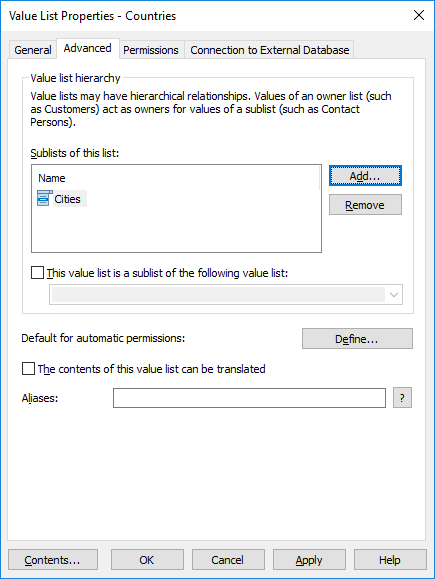Advanced Value List Properties
Value list hierarchy

In the advanced settings, various hierarchical relationships can be defined.
Defining an Internal Hierarchy for a Value List
A value list can be hierarchical in itself, meaning that it can contain items and subitems. A parent item collects related subitems. This way, you can create, for example, a value list containing all drawing types hierarchically. The parent object can be for instance a floor plan, with floor plans in different scales as its subobjects. Regardless of their internal hierarchy, all items in the hierarchical value list represent the same concept (for example, the parent item Floor plan and its subitems Floor plan 1:100 and Floor plan 1:50).
Do the following steps to define an internal hierarchy for a value list:
Defining a Hierarchical Relationship Between Value Lists
If a parent item and subitems represent different concepts, such as countries and their cities, separate value lists must be created for the items and the value lists must be defined as two hierarchically related value lists. In such a case, the item in the Countries value list (country name) is the owner value for the items in the Cities value list. The Countries value list is then the higher-level list and the Cities list is its sublist.
Do the following steps to define a hierarchical relationship between two value lists:
Default for automatic permissions
You can activate the automatic permissions by value, value list, object type, or class. You can specify the automatic permissions for each value list in the same way as for each value. The automatic permissions are attached to an object when a value with automatic permissions is added for the object.
The contents of this value list can be translated
Enable this option to allow the contents of the selected value list to be translated to different languages. For more information, see Languages and Translations.
Value list aliases
Using the Aliases field, you can define an alias for the value list. For more information, see Associating the Metadata Definitions.
When you have automatic aliases in use and you write a name on the General tab, the Aliases field on the Advanced tab is automatically filled in. The alias has the format <predefined prefix>.<name>. Define automatic aliases for your vault in the configurations editor.
